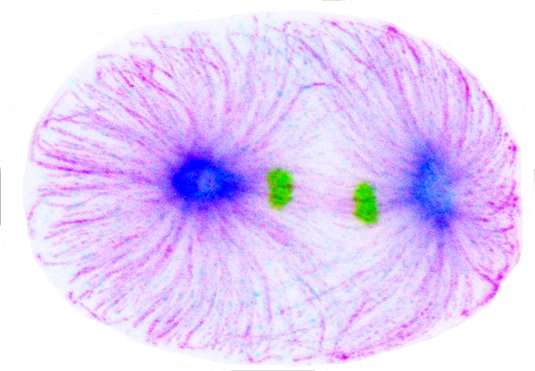A signaling pathway that restricts cleavage furrow formation to the mid-plane of the cell

Cell division is a fundamental biological process which ensures that, following the replication of the mother cell's genome, the two sets of chromosomes are equally distributed between two daughter cells. Chromosomes are segregated by the spindle apparatus, which is made up of fibrous protein structures called microtubules. The spindle apparatus is anchored to the opposite poles of the cell and determines the position of the future cleavage site in the middle of the cell, where a contractile protein ring is assembled. LMU researchers led by cell biologist Dr. Esther Zanin, who heads an Emmy Noether Research Group at the LMU Biocenter, have identified a molecular signaling pathway that restricts formation of the contractile ring to the mid-plane of the mother cell.
Their findings appear in the Journal of Cell Biology.
Correct segregation of the chromosomes requires precise positioning of the cleavage furrow to the mid-plane of the cell. To achieve this, the spindle apparatus sends out two signals. One of these actively stimulates formation of the contractile ring at the mid-plane of the cell while a second signal inhibits its assembly at the cell poles. The inhibitory signal is known to originate from the so-called astral microtubules, which project to the cell poles from the spindle apparatus. "However, the molecular constituents of this signal have remained unknown until now," says Zanin. "With the help of a newly developed and highly sensitive method, we have now shown in the nematode Caenorhabditis elegans – a popular model organism in cell biology – that the enzyme Aurora A is a central component of the inhibitory signal."
Aurora A, which is also present in human cells, is known to play a crucial role in the control of spindle assembly, and is activated on the astral microtubules. "We think that the active enzyme then diffuses from the astral microtubules to the cell membrane at the cell poles, where it suppresses formation of a contractile ring." Zanin explains. In multicellular organisms, the precise control of cell division is not only essential during embryonic development, but also in the adult organism. Defects in cell division can causes numerous diseases including cancers." A detailed understanding of this fundamental process is therefore a prerequisite for the development of more effective ways to treat and prevent such disorders," says Zanin.
More information: Sriyash Mangal et al. TPXL-1 activates Aurora A to clear contractile ring components from the polar cortex during cytokinesis, The Journal of Cell Biology (2018). DOI: 10.1083/jcb.201706021
Journal information: Journal of Cell Biology
Provided by Ludwig Maximilian University of Munich

















